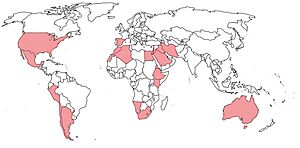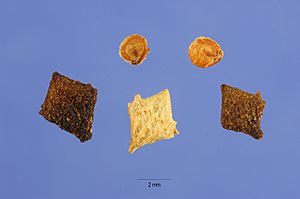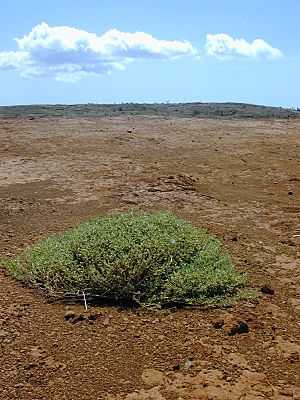Australian saltbush facts for kids
Quick facts for kids Australian saltbush |
|
|---|---|
 |
|
| Conservation status | |
| Scientific classification | |
| Genus: |
Atriplex
|
| Species: |
semibaccata
|
| Synonyms | |
|
|
Atriplex semibaccata, also known as Australian saltbush, berry saltbush, or creeping saltbush, is a type of flowering plant. It belongs to the Amaranthaceae family. This plant is native only to Australia.
It is a perennial herb, meaning it lives for many years. You can find it naturally in Western Australia, South Australia, Queensland, and New South Wales. However, it has also spread to other Australian states and many countries around the world. The plant flowers and produces fruit in spring. Its seeds spread when the fruit opens. This saltbush is very tough. It can handle changing rainfall, extreme temperatures, and poor soil. People use it to fix damaged land, for medicine, as a cover crop, and as fodder (food for animals). When it was brought to other countries, it had both good and bad effects on their environment and economy.
Contents
What is Australian Saltbush?
Atriplex semibaccata is a perennial herb with a deep taproot. It often grows low to the ground, spreading out like a mat. It can also grow semi-upright. This plant can reach 40–80 cm (about 1.5 to 2.5 feet) tall. It can spread out to 1.5–2 meters (about 5 to 6.5 feet) wide. Its thin branches grow from a woody taproot.
Leaves and Flowers
The leaves are first white and fuzzy. They are small and have a tiny stalk. When young, they are spoon-shaped or egg-shaped. As they grow, they turn green to grey-green. They are 5–30 mm long and 2–9 mm wide. The leaves are thin, oblong, and have short stalks.
The plant has tiny male flowers that are about 1.5 mm wide. Female flowers grow in clusters away from the leaves. A. semibaccata is a monoecious plant. This means it has both male and female flowers on the same plant.
Fruits and Seeds
The fruits are called bracteoles. They turn red or orange when they are ripe. They are round and have a diamond-like shape. The fruits are juicy and joined at the base. They have toothed edges and are 4–6 mm long.
A. semibaccata grows from seeds. It has two types of seeds, which is called "dimorphic." Black seeds are 1.5–1.7 mm, and brown seeds are 2 mm. This plant is good for land that is damaged or salty. It grows best in dry, subtropical climates with lots of sunlight. It stays interesting all year. It needs light water in clay, loam, peat, sand, or silt soil. The soil should have a neutral soil pH.
How it Got its Name
The plant Atriplex semibaccata was first officially described in 1810. This was done by Robert Brown (botanist, born 1773) in his book Prodromus Florae Novae Hollandiae et Insulae Van Diemen. It is part of the Amaranthaceae family. This family also includes other salt-tolerant plants.
There are different types of A. semibaccata. These types show small differences in how the plant looks. In Western Australia, the fruits are juicy and diamond-shaped. In Queensland and New South Wales, the fruits are thinner and dry. A. semibaccata can also mix with another plant, Atriplex spinibractea. This creates a new type of plant.
Scientists have studied A. semibaccata using genetic tests. They found that it is quite different from other Atriplex species. This shows it belongs to its own special group.
The common names for A. semibaccata include "Australian saltbush," "Australian saltweed," "creeping saltbush," and "berry saltbush." The name Atriplex comes from a Latin word meaning "saltbush." The species name semibaccata comes from Latin words meaning "half" and "bearing berries." This refers to its juicy, berry-like fruits.
Where Australian Saltbush Grows
This saltbush plant is native to Australia. It grows naturally in Western Australia, South Australia, Queensland, and New South Wales. It has also started growing on its own in the Australian Capital Territory, Norfolk Island, and possibly Tasmania.
People have also brought it to many other parts of the world. This includes North and South America, Africa, the Middle East, and Asia. It was introduced because it can handle drought and salty conditions. It is used as a fodder crop for animals. In Tasmania, it was brought for grazing animals.
A. semibaccata likes heavy, slightly salty soil. It often grows in woodlands near salt lakes. It can also take over disturbed areas. It was first seen in California in 1901. There, it was used to feed livestock in salty areas. By 1940, it had spread along the southern coast of California. It grows best in dry or subtropical climates with direct sunlight.
How Australian Saltbush Lives
How it Reproduces
A. semibaccata reproduces by seeds. When the fruits are ripe and dry, they split open. This releases a single seed. The plant can fertilize itself. It is also pollinated by wind. Male flowers grow in small clusters near the ends of branches. Female flowers appear in scattered clusters near the leaves. We don't know much about how long the seeds last in the soil. However, the seeds usually sprout well without needing a rest period.
In Australia, A. semibaccata flowers and fruits in spring and summer. In Western Australia, it flowers for a longer time. In the Northern Hemisphere (like the USA), it usually flowers in spring, summer, and early winter.
How it Adapts
A. semibaccata is very good at adapting to its environment. It can change how it grows based on things like air temperature, soil moisture, salinity (saltiness), and how much water evaporates.
If there is a lot of salt, the plant shows "salt stress." This means it has fewer chloroplasts (parts of plant cells that make food). Its roots and leaves also get smaller. But it can also increase the number of stomata (tiny pores) on its leaves. This helps it handle the salt.
During winter, A. semibaccata becomes inactive. This is different from some other saltbush species that keep growing. The plant can adapt to low and changing rainfall, different temperatures, humidity, and poor soil.
Growing Australian Saltbush
What it Needs to Grow
A. semibaccata is from Australia. It does not grow well in very wet or humid places. It is a drought-tolerant plant. It likes dry and semi-dry regions. It grows best where the average rainfall is 250–900 mm per year. It is a low-spreading plant with deep roots. It does not need a lot of soil moisture. It grows best in sunny areas.
This plant can handle winter and can survive temperatures as low as -5 °C. It can also handle salty winds. This gives it an advantage over other plants near the coast. Salty soil helps its seeds sprout quickly and in large numbers. This helps it compete with native species around the world. A. semibaccata can handle a lot of salt. It grows in different soil types, like clay, sandy soil, and even waterlogged areas.
How it Spreads
A. semibaccata seeds usually spread short distances. They are often found under other plants. But animals can spread the seeds much farther. The red, juicy fruits are attractive to plant-eating animals. Animals that eat the fruits help spread the seeds. For example, A. semibaccata seeds have been found in the stomachs of reptiles, birds, and foxes in California, USA.
Sometimes, A. semibaccata is accidentally spread. This happens when hay or other animal feed is moved. But often, it is spread on purpose. People plant it in other countries because it can handle drought and salt. They use it as fodder and as a ground cover.
Uses of Australian Saltbush
As a Cover Crop
In Australia, A. semibaccata is used in farming to help vineyards grow better. It is planted as a cover crop in places with little water. It helps stop pests from damaging other plants. Native perennial cover crops like A. semibaccata can increase the number of helpful insects. These insects can control pests naturally. This means less need for chemical pest control.
For Fixing Land
A. semibaccata has been used to help fix land damaged by mining. It can grow in the salty and dry conditions of mining waste. It also sprouts well in these areas. People use it for landscaping and as ground cover to stop soil erosion. It is good for controlling weeds along roadsides and in roundabouts. It can also help reclaim damaged land without needing salty water for irrigation. It helps restore bare patches of ground.
As Animal Feed
A. semibaccata is used as pasture on salty land. It provides fodder for grazing animals when other food is scarce. This can help improve farms on salty land. It also helps reduce salt movement and makes the soil structure better. A. semibaccata is a good food source for animals. However, it has a high salt content. So, animals need enough drinking water if they eat a lot of it. It is tasty when young and provides some protein. Animals may need other food supplements too.
For Medicine
The essential oils from A. semibaccata have compounds that can fight bacteria and act as antioxidants. These essential oils work well with gentamicin, an antibiotic used for bacterial infections. This means A. semibaccata could be used to help control infections. Extracts from the plant also have antibacterial properties. Some compounds found in A. semibaccata can even fight against leukemia cells.
Impact on the Environment
A. semibaccata grows and spreads over short distances. It forms a thick, fire-retardant ground cover. This can push out native plant species. In the USA, it is considered an invasive species. It can harm endangered species like Panicum niihauense and Sesbania tomentosa in Hawaii. In California, it competes with native plants for space, shade, water, and light. This competition can change the ecosystem and harm native habitats.
However, A. semibaccata can also help the environment. When used as a cover crop, it can increase the number of helpful insects. These insects help control pests. It also provides shelter for various invertebrates. This increases the variety of life in the soil. This helps break down organic material and cycle nutrients. This keeps A. semibaccata and nearby plants healthy. It also supports predators that stop harmful organisms from growing too much. This helps protect crops. A. semibaccata can improve soil quality, stop weeds, and help manage pests.
Economic Impact
The economic impact of A. semibaccata can be good where it is not invasive. It helps with land repair, has medicinal uses, and is valuable as animal food and a cover crop.
However, its invasiveness can cause negative economic effects. It endangers native species, changes the environment, and affects biodiversity. This means people have to spend money and effort to control it. They use herbicides like dicamba or 2,4-D. Physically removing the plant by hand is also effective, especially before it produces seeds. Areas where it has grown need to be checked often to remove new plants.
Images for kids
-
Invasive growth in the Canary Islands, Spain
See also
 In Spanish: Atriplex semibaccata para niños
In Spanish: Atriplex semibaccata para niños









